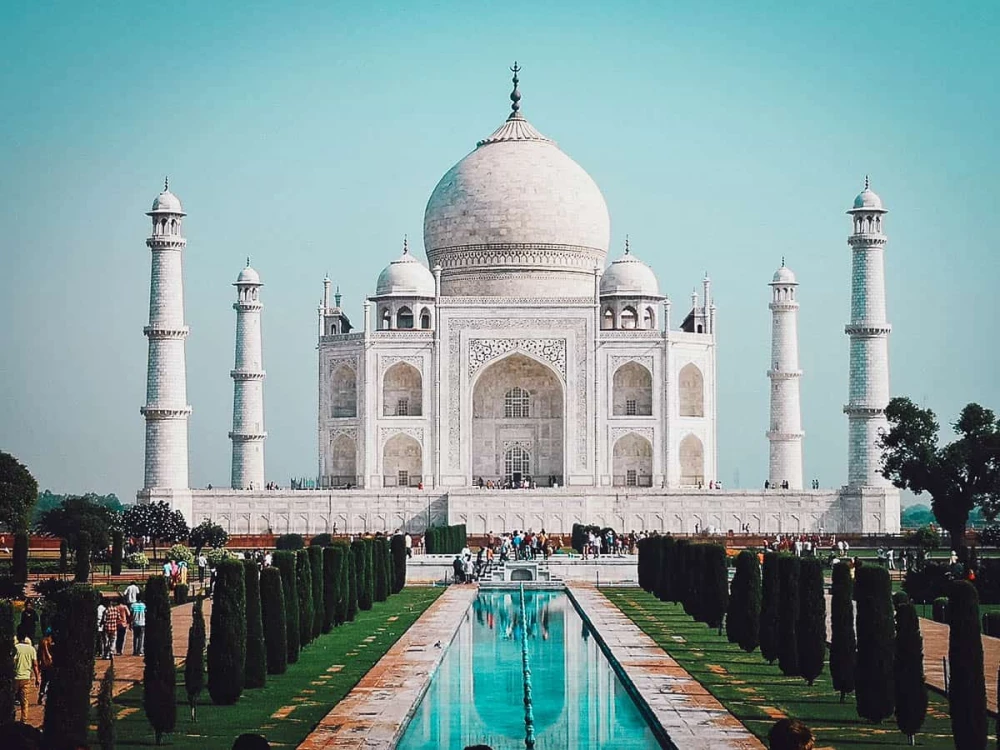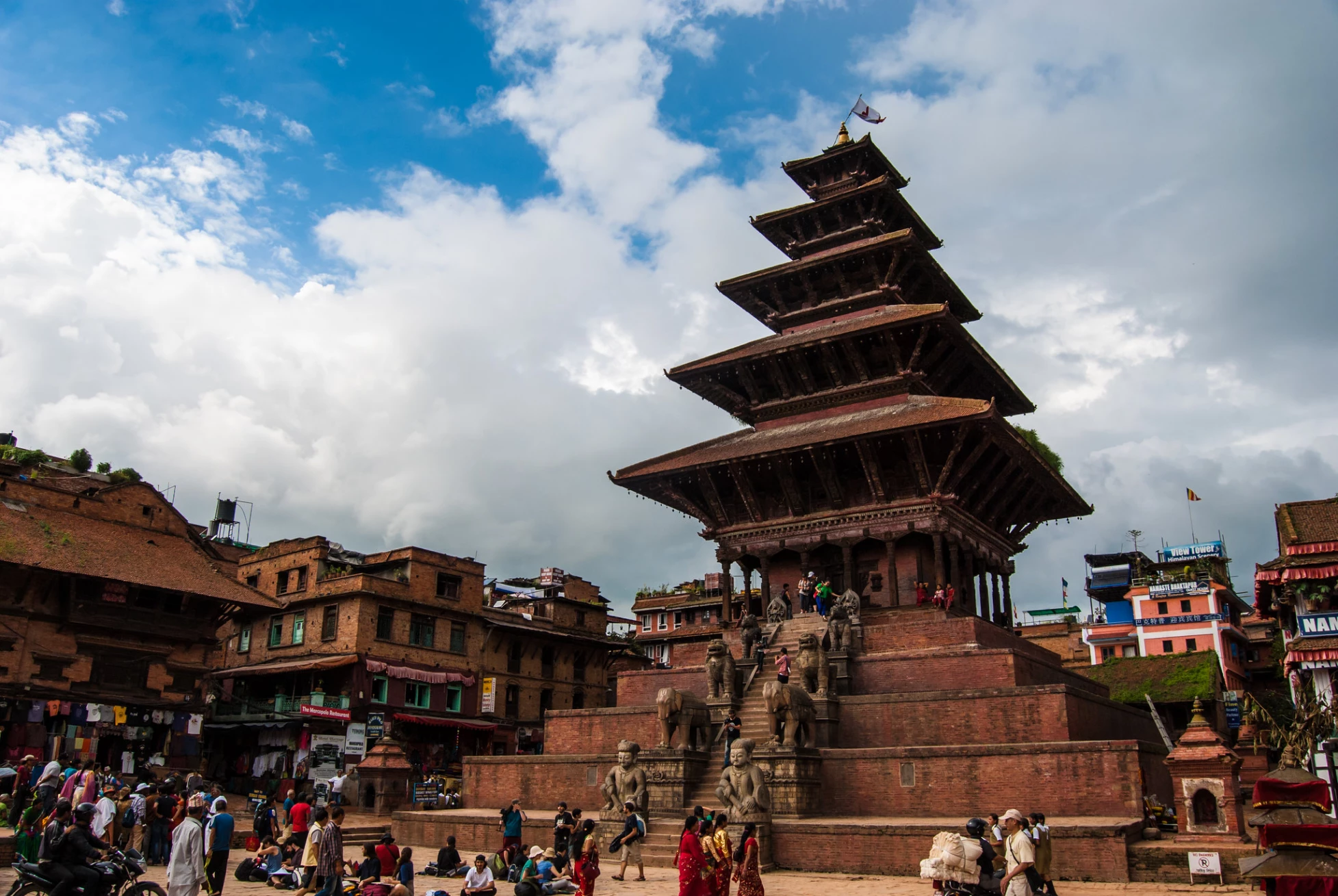
Nepal
Region map
General information
Nepal Reopening
Nepal has fully reopened its borders as of 10 March 2022, after nearly two years of closure. Tourists are welcome back with no quarantine, no test on arrival, and just a minimum of requirements as below.
If you’re fully vaccinated
When flying to Nepal from or through the UK, you will need to present certain documentation:
- a visa or prior approval document. Those certified vaccinated, can secure a visa on arrival
- a travel insurance document which covers health, immediate crisis, or rescue for the duration of your travel
- a barcode generated from the online application of the Online International Travel Arrival Form. See ARMS-DIMS
If you are not fully vaccinated, you will not be able to get a visa on arrival. You should apply in your country of origin. You will also need to show that you have taken a PCR test within 72 hours of your flight of first departure. In addition, you will be required to take an antigen test for COVID19 on arrival at the airport.
If you test positive, you will be required to quarantine in Government-provided facilities at your own expense.
You should also be ready to show evidence of your initial hotel booking.
If you’re not fully vaccinated
The Government of Nepal defines people who are fully vaccinated as those who have received full doses of an approved vaccine more than 14 days previously. If you’re not fully vaccinated, you must obtain a visa from a Nepali embassy overseas. You will not be able to get one on arrival.
You are required to submit the following documents when at the immigration entry point in Nepal:
- COVID-19 negative report obtained within 72 hours of the departure from the first port of embarkation.
- a travel insurance document which covers health, immediate crisis, or rescue for the duration of your travel
- Printed copy of International Traveller Online Arrival Form obtained after online registration ARMS-DIMS. You should also be ready to show evidence of your initial hotel booking.
Unvaccinated people, or those unable to show that they have been fully vaccinated for at least fourteen days, are also subject to free antigen tests on arrival. This applies to all passengers aged over five years old.
Children and young people
Children aged 5 years and under do not require to be vaccinated or tested when arriving to Nepal. Children aged 17 and under do not require to be vaccinated when travelling to Nepal, but are subject to follow the other health protocols as adults.
General information
The name “Nepal” is first recorded in texts from the Vedic Age, the era in which Hinduism was founded, the predominant religion of the country. In the middle of the first millennium BCE, Gautama Buddha, the founder of Buddhism, was born in southern Nepal. Parts of northern Nepal were intertwined with the culture of Tibet. The centrally located Kathmandu Valley was the seat of the prosperous Newar confederacy known as Nepal Mandala. The Himalayan branch of the ancient Silk Road was dominated by the valley’s traders. The cosmopolitan region developed distinct traditional art and architecture. By the 18th century, the Gorkha Kingdom achieved the unification of Nepal. The Shah dynasty established the Kingdom of Nepal and later formed an alliance with the British Empire, under its Rana dynasty of premiers. The country was never colonised but served as a buffer state between Imperial China and colonial India.Parliamentary democracy was introduced in 1951, but was twice suspended by Nepalese monarchs, in 1960 and 2005. The Nepalese Civil War in the 1990s and early 2000s resulted in the proclamation of a secular republic in 2008, ending the world’s last Hindu monarchy.
The Constitution of Nepal, adopted in 2015, establishes Nepal as a federal secular parliamentary republic divided into seven provinces. Nepal was admitted to the United Nations in 1955, and friendship treaties were signed with India in 1950 and the People’s Republic of China in 1960. Nepal hosts the permanent secretariat of the South Asian Association for Regional Cooperation (SAARC), of which it is a founding member. Nepal is also a member of the Non Aligned Movement and the Bay of Bengal Initiative. The military of Nepal is the fifth largest in South Asia; it is notable for its Gurkha history, particularly during the world wars, and has been a significant contributor to United Nations peacekeeping operations. Let's discover Nepal with Adventure Asia!
Nepal itineraries
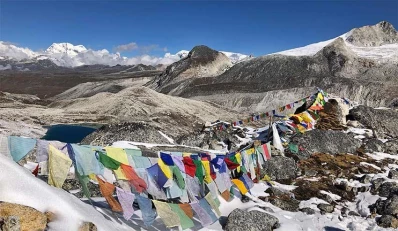
The greatest Snowman Trek in Bhutan
"To have wonderful memories is an asset to be invested in one's life as life itself is a matter of time." For those seeking great adventure in the snowy mountains of the north then this famous Snowman Trek is made for you! Considered as one of the most difficult but also the most rewarding trekking trails on earth, this 30 days journey follows the spine of the Himalayas between Bhutan and Tibet, from Paro in the west to Trongsa in the east and it offers you both beauty, variety and wilderness. From these unexplored mountain trails, serene alpine villages to the crystal clear lakes, from the 11 splendid passes over 4500 metres to the spectacular cliff-face Taktsang 'Tiger's Nest' Monastery and one of the remotest inhabited valleys on the planet, Kingdom of Lunana, Bhutan is inarguably the perfect place to be for a trekking enthusiast!
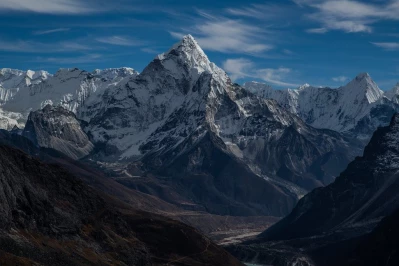
15-Day Trek to the Everest Base Camp
The fascinating views of the Himalayas will stay with you for all of time. You'll start at the Kathmandu valleys before making your way to Phakding Lukla. The adventure begins by crossing over the Tharo Kosi river via a suspension bridge. Already, the breathtaking Kusum Kanguru peak will show itself. Expect to see gorgeous ridges painted with mani stones before crossing the Dudh Kosi River on to Phakding. From here, quaint villages interspersed between incredible forestry greet you regularly. The Kyashar Kholar river follows. It leads you to Monjo and then the Sagarmatha National Park. Soon, you'll arrive at the Namche Bazaar, a trading center.
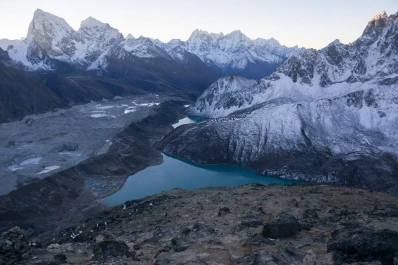
19-Day Trek to Gokya-Ri and the Everest Base Camp
Witness breathtaking sites of Mount Everest and its neighboring peaks as you take this weeks-long trek. You'll begin in the Gundu valley before heading to Lukla by air and then to Chablung. Cross the Tharo Kosi river via a locally designed suspension bridge — one of many you'll pass over. From here you'll see the Kusum Kanguru peak. See the first of a few mani-stone painted ridges as you had to Phakding. Walk along the Dudh Kosi river on your way to Namche Bazaar, a trading center. You'll several villages separated by various forestry before arriving. Cross again at the Kyashar Khola river as you head to Monjo and then the Sagarmatha National Park. To acclimatize, you'll hike to the gorgeous villages of Thame, Phurte, Thamo, and Somde to reach Thami. Mounts Teng Kang Poche and Kwangde can be seen from here. On to Dole, you'll also see Khumbila and Tawache. You'll next head to Macchermo, and then Pangku, which is home to a large cave. Lake Longponga and Taujun both lie ahead of Gokyo, the home of stone houses and walled pastures. As you move on to the Cho La pass, you'll trek up to Kala Patter and, finally, the Everest Base Camp.
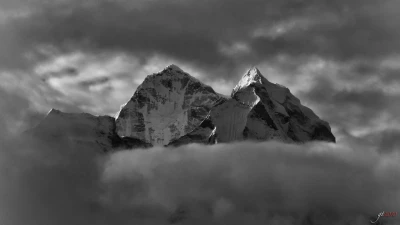
Trek to Mount Everest and Stay in Luxury Lodges
Witness a once-in-a-life panoramic view of Mount Everest and several surrounding mountains as you explore this white Himalayan paradise. Take in the culture and lifestyle of the locals while you're at it. This journey begins with an easy trek to the village of Monjo where you'll sleep at the Summit Lodge. The challenge continues with an ascent to the gorgeous Namche Bazaar. Walk along the Dudh Kosi, AKA, the River of Milk, crossing several suspension bridges and trudging through rhododendron, magnolia, and fir forests. You'll eventually arrive at the Everest Base Camp. Here, the peaks of Mount Everest and Ama Dablam come into sight. You'll head on to Tashinga before making your way up the challenging trail. Along the way, you'll visit the Tengboche monastery — the most important in the Sherpa region. Descend the next day and branch off into the Khumjung village, the education center. Soon enough, you'll reach an incredible lodge in Mende.
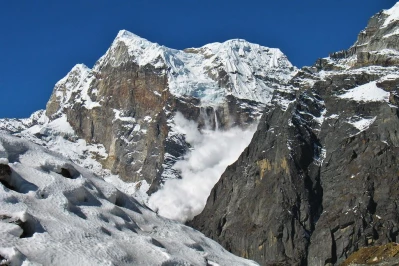
15-Day Trek from Renjo La to Gokyo
See incredible views of Mount Everest and the Gokyo-Ri. You’ll first warm up with a tour through the Gundu Valley. From Luka to Chablung, you’ll cross over the Tharo Kosi river via a suspension bridge. Here, the peak of the Kusum Kanguru comes into sight. Closer to you is an intriguing ridge painted with mani stones. Trek on to Phakding and then the valley of the Dudh Kosi river. Pass through other-worldly villages interspersed with amazing forests. After crossing the Kyashar Khola river, you’ll reach Monjo and then the Sagarmatha National Park. Another suspension bridge takes you to Jorsale and then the trading center Namche Bazaar. Your next stop is Phortse Thanga. More forest floor takes you to Dole and then Macchermo. You’ll finally arrive at Gokyo and see Cho Oyu, Everest, Gyanchung Kang, Lothse, Makalu, Cholatse, and Tawache. Then, you’ll cross the Renjo La Pass and go to the Nangaml valley before making your descent.

15-Day Trek through Gokyo-Ri to Mount Everest
Get to see incredible close-up views of Mount Everest as you travel down valleys, crossing rivers over tall, local-style suspension bridges. Incredible views of Teng Kang Poche and Kangde are your next delight. Climb to Khumjung then on to Dudh Kosi. Then you go from Tongba to Dole where we will see the Khumbila and Tawachee peaks. Another day will bring you to the Nilibuk cave and the Longponga lake. Then reach Gokyo, which provides breathtaking views of Cho Oyu, Gyanchung Kang, Everest, Lothse, Makalu, Cholatse, and Tawachee.
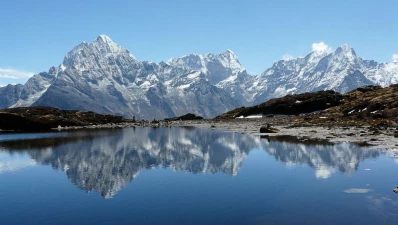
11-Day Trek for Panoramic Views of Everest, Lhotse, and Ama Dablam
Witness breathtaking views of Mount Everest and its Himalayan neighbors as you hike through this scenic route. You’ll go from Kathmandu, the home to sacred temples and shrines. On to Lukla, cross the Tharo Kosi river to see the peak of the Kusum Kanguru. Walk past some painted mani stones to reach Phakding. You’ll next follow the valley of the Dudh Kosi river, then climb a steep ridge to Benkar. Continuing on, take in scenic views of several villages interspersed with forests of rhododendron, magnolia, and giant firs. Cross the Kyashar Khola river as you head to Monjo and the Sagarmatha National Park. Your next stop will be the trading centre of Namche Bazaar. Then go to the Khumjung village, where you’ll get an incredible view of Mount Everest. The descent from here will take you through Chomoa, where an agriculture project lies.
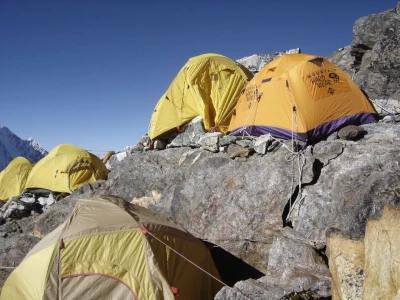
12-Day Trek to the Ama Dablam Base Camp
You’ll see breathtaking views of Ama Dablam and the Lothse peak on this challenging but rewarding trek up to the Ama Dablam base camp. Your first stop is at either the Bhaktapur or Kathmandu Valley. Pass several villages interspersed with magnolia, rhododendron, and fir forests before crossing another river, the Kyashar Khola. The Sagarmatha National Park awaits. A local-style suspension bridge takes you across the Dhud Kosi again. Eventually, you’ll arrive at trading centre Namche Bazaar. Visiting the surrounding villages will help you acclimatize for the trek ahead. On to the Tengboche monastery, witness incredible views of Everest and Ama Dablam, then later of Kwangde, Tawachee, Nuptse, Lhotse, Kantega, and Thamserku. A day later you’ll reach the Ama Dalam Base, where you’ll also see the Island Peak, as well as the south face of Lothse, and the Ama Dablam.

Trek from Kathmandu to the Nagarkot Mountain Resort
See gorgeous views of the Himalayas as you explore surrounding mountains and visit a resort. You’ll go from the Kathmandu valley to the Kakani village. Here, you’ll explore the rhododendron and oak forests. Already, you’ll be greeted with incredible views of the Dhaulagiri, the Annapurna range, and everything up to the Ganesha Himal. After camping at High Hill, you’ll walk up to Shivapuri. Abundant wildlife and a variety of birds are prevalent here. You’ll also see the watershed which provides for the Kathmandu valley. This over 500-year old town is home to the Newar people, who will give you a taste of their unique artistry as you walk among beautifully-carved houses, statues, temples.

20-Day Trek to Everest Base Camp through the Three Passes
Get up close and personal with the tallest peaks of the Himalayas you walk through three of Nepal’s highest passes — the Kongma La, Cho La, and the Renjo La. You’ll start at The Kathmandu valley is home to tons of monasteries and sanctuaries, and make your way across the Tharo Kosi River. A variety of forests including rhododendron, magnolia, and fir await. Several Sherpa villages will greet you as you pass through valleys, and visit the Sagarmatha National Park. The Everest Base Camp is an important stop on the trek. There’s a stop at Namche Bazaar. In addition to the three major passes, you’ll see the longest glacier in the region — the Ngozumpa glacier. More importantly, though, you’ll find your courage as you make your way to some of the tallest locations of what many rightly call a once-in-a-lifetime journey that you will never forget.

The greatest Snowman Trek in Bhutan
"To have wonderful memories is an asset to be invested in one's life as life itself is a matter of time." For those seeking great adventure in the snowy mountains of the north then this famous Snowman Trek is made for you! Considered as one of the most difficult but also the most rewarding trekking trails on earth, this 30 days journey follows the spine of the Himalayas between Bhutan and Tibet, from Paro in the west to Trongsa in the east and it offers you both beauty, variety and wilderness. From these unexplored mountain trails, serene alpine villages to the crystal clear lakes, from the 11 splendid passes over 4500 metres to the spectacular cliff-face Taktsang 'Tiger's Nest' Monastery and one of the remotest inhabited valleys on the planet, Kingdom of Lunana, Bhutan is inarguably the perfect place to be for a trekking enthusiast!

A Taste of Tibet
Travel to the Potala Palace, the seat of the Dalai Lama, on this fulfilling journey through Tibet. Exploration of the palace is open to the public. Tremendous views are also at your fingertips. You’ll even witness some animated monks holding traditional debates in the courtyard.

The greatest Snowman Trek in Bhutan
"To have wonderful memories is an asset to be invested in one's life as life itself is a matter of time." For those seeking great adventure in the snowy mountains of the north then this famous Snowman Trek is made for you! Considered as one of the most difficult but also the most rewarding trekking trails on earth, this 30 days journey follows the spine of the Himalayas between Bhutan and Tibet, from Paro in the west to Trongsa in the east and it offers you both beauty, variety and wilderness. From these unexplored mountain trails, serene alpine villages to the crystal clear lakes, from the 11 splendid passes over 4500 metres to the spectacular cliff-face Taktsang 'Tiger's Nest' Monastery and one of the remotest inhabited valleys on the planet, Kingdom of Lunana, Bhutan is inarguably the perfect place to be for a trekking enthusiast!

15-Day Trek to the Everest Base Camp
The fascinating views of the Himalayas will stay with you for all of time. You'll start at the Kathmandu valleys before making your way to Phakding Lukla. The adventure begins by crossing over the Tharo Kosi river via a suspension bridge. Already, the breathtaking Kusum Kanguru peak will show itself. Expect to see gorgeous ridges painted with mani stones before crossing the Dudh Kosi River on to Phakding. From here, quaint villages interspersed between incredible forestry greet you regularly. The Kyashar Kholar river follows. It leads you to Monjo and then the Sagarmatha National Park. Soon, you'll arrive at the Namche Bazaar, a trading center.

19-Day Trek to Gokya-Ri and the Everest Base Camp
Witness breathtaking sites of Mount Everest and its neighboring peaks as you take this weeks-long trek. You'll begin in the Gundu valley before heading to Lukla by air and then to Chablung. Cross the Tharo Kosi river via a locally designed suspension bridge — one of many you'll pass over. From here you'll see the Kusum Kanguru peak. See the first of a few mani-stone painted ridges as you had to Phakding. Walk along the Dudh Kosi river on your way to Namche Bazaar, a trading center. You'll several villages separated by various forestry before arriving. Cross again at the Kyashar Khola river as you head to Monjo and then the Sagarmatha National Park. To acclimatize, you'll hike to the gorgeous villages of Thame, Phurte, Thamo, and Somde to reach Thami. Mounts Teng Kang Poche and Kwangde can be seen from here. On to Dole, you'll also see Khumbila and Tawache. You'll next head to Macchermo, and then Pangku, which is home to a large cave. Lake Longponga and Taujun both lie ahead of Gokyo, the home of stone houses and walled pastures. As you move on to the Cho La pass, you'll trek up to Kala Patter and, finally, the Everest Base Camp.

Trek to Mount Everest and Stay in Luxury Lodges
Witness a once-in-a-life panoramic view of Mount Everest and several surrounding mountains as you explore this white Himalayan paradise. Take in the culture and lifestyle of the locals while you're at it. This journey begins with an easy trek to the village of Monjo where you'll sleep at the Summit Lodge. The challenge continues with an ascent to the gorgeous Namche Bazaar. Walk along the Dudh Kosi, AKA, the River of Milk, crossing several suspension bridges and trudging through rhododendron, magnolia, and fir forests. You'll eventually arrive at the Everest Base Camp. Here, the peaks of Mount Everest and Ama Dablam come into sight. You'll head on to Tashinga before making your way up the challenging trail. Along the way, you'll visit the Tengboche monastery — the most important in the Sherpa region. Descend the next day and branch off into the Khumjung village, the education center. Soon enough, you'll reach an incredible lodge in Mende.

15-Day Trek from Renjo La to Gokyo
See incredible views of Mount Everest and the Gokyo-Ri. You’ll first warm up with a tour through the Gundu Valley. From Luka to Chablung, you’ll cross over the Tharo Kosi river via a suspension bridge. Here, the peak of the Kusum Kanguru comes into sight. Closer to you is an intriguing ridge painted with mani stones. Trek on to Phakding and then the valley of the Dudh Kosi river. Pass through other-worldly villages interspersed with amazing forests. After crossing the Kyashar Khola river, you’ll reach Monjo and then the Sagarmatha National Park. Another suspension bridge takes you to Jorsale and then the trading center Namche Bazaar. Your next stop is Phortse Thanga. More forest floor takes you to Dole and then Macchermo. You’ll finally arrive at Gokyo and see Cho Oyu, Everest, Gyanchung Kang, Lothse, Makalu, Cholatse, and Tawache. Then, you’ll cross the Renjo La Pass and go to the Nangaml valley before making your descent.

15-Day Trek through Gokyo-Ri to Mount Everest
Get to see incredible close-up views of Mount Everest as you travel down valleys, crossing rivers over tall, local-style suspension bridges. Incredible views of Teng Kang Poche and Kangde are your next delight. Climb to Khumjung then on to Dudh Kosi. Then you go from Tongba to Dole where we will see the Khumbila and Tawachee peaks. Another day will bring you to the Nilibuk cave and the Longponga lake. Then reach Gokyo, which provides breathtaking views of Cho Oyu, Gyanchung Kang, Everest, Lothse, Makalu, Cholatse, and Tawachee.

11-Day Trek for Panoramic Views of Everest, Lhotse, and Ama Dablam
Witness breathtaking views of Mount Everest and its Himalayan neighbors as you hike through this scenic route. You’ll go from Kathmandu, the home to sacred temples and shrines. On to Lukla, cross the Tharo Kosi river to see the peak of the Kusum Kanguru. Walk past some painted mani stones to reach Phakding. You’ll next follow the valley of the Dudh Kosi river, then climb a steep ridge to Benkar. Continuing on, take in scenic views of several villages interspersed with forests of rhododendron, magnolia, and giant firs. Cross the Kyashar Khola river as you head to Monjo and the Sagarmatha National Park. Your next stop will be the trading centre of Namche Bazaar. Then go to the Khumjung village, where you’ll get an incredible view of Mount Everest. The descent from here will take you through Chomoa, where an agriculture project lies.

12-Day Trek to the Ama Dablam Base Camp
You’ll see breathtaking views of Ama Dablam and the Lothse peak on this challenging but rewarding trek up to the Ama Dablam base camp. Your first stop is at either the Bhaktapur or Kathmandu Valley. Pass several villages interspersed with magnolia, rhododendron, and fir forests before crossing another river, the Kyashar Khola. The Sagarmatha National Park awaits. A local-style suspension bridge takes you across the Dhud Kosi again. Eventually, you’ll arrive at trading centre Namche Bazaar. Visiting the surrounding villages will help you acclimatize for the trek ahead. On to the Tengboche monastery, witness incredible views of Everest and Ama Dablam, then later of Kwangde, Tawachee, Nuptse, Lhotse, Kantega, and Thamserku. A day later you’ll reach the Ama Dalam Base, where you’ll also see the Island Peak, as well as the south face of Lothse, and the Ama Dablam.

Trek from Kathmandu to the Nagarkot Mountain Resort
See gorgeous views of the Himalayas as you explore surrounding mountains and visit a resort. You’ll go from the Kathmandu valley to the Kakani village. Here, you’ll explore the rhododendron and oak forests. Already, you’ll be greeted with incredible views of the Dhaulagiri, the Annapurna range, and everything up to the Ganesha Himal. After camping at High Hill, you’ll walk up to Shivapuri. Abundant wildlife and a variety of birds are prevalent here. You’ll also see the watershed which provides for the Kathmandu valley. This over 500-year old town is home to the Newar people, who will give you a taste of their unique artistry as you walk among beautifully-carved houses, statues, temples.

20-Day Trek to Everest Base Camp through the Three Passes
Get up close and personal with the tallest peaks of the Himalayas you walk through three of Nepal’s highest passes — the Kongma La, Cho La, and the Renjo La. You’ll start at The Kathmandu valley is home to tons of monasteries and sanctuaries, and make your way across the Tharo Kosi River. A variety of forests including rhododendron, magnolia, and fir await. Several Sherpa villages will greet you as you pass through valleys, and visit the Sagarmatha National Park. The Everest Base Camp is an important stop on the trek. There’s a stop at Namche Bazaar. In addition to the three major passes, you’ll see the longest glacier in the region — the Ngozumpa glacier. More importantly, though, you’ll find your courage as you make your way to some of the tallest locations of what many rightly call a once-in-a-lifetime journey that you will never forget.
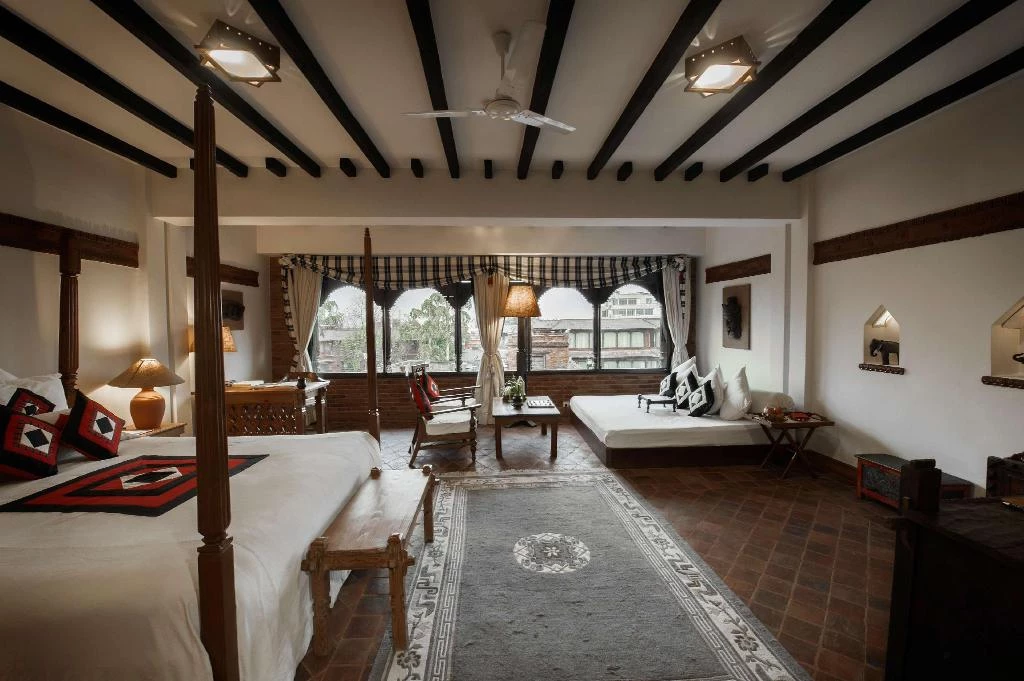
Dwarika's Hotel - Kathmandu
Dwarika's Hotel - Kathmandu

Dwarika's Dhulikhel resort - Kathmandu
At The Dwarika’s Resort, we believe in the need for maintaining harmony between body, mind, spirit and earth in order to enjoy a peaceful, healthy and balanced life. Drawing on ancient Hindu scriptures, Buddhist medicine and traditional Himalayan knowledge, the resort is founded on a philosophy of respecting nature and the self.
Dwarika's Dhulikhel resort - Kathmandu
At The Dwarika’s Resort, we believe in the need for maintaining harmony between body, mind, spirit and earth in order to enjoy a peaceful, healthy and balanced life. Drawing on ancient Hindu scriptures, Buddhist medicine and traditional Himalayan knowledge, the resort is founded on a philosophy of respecting nature and the self.
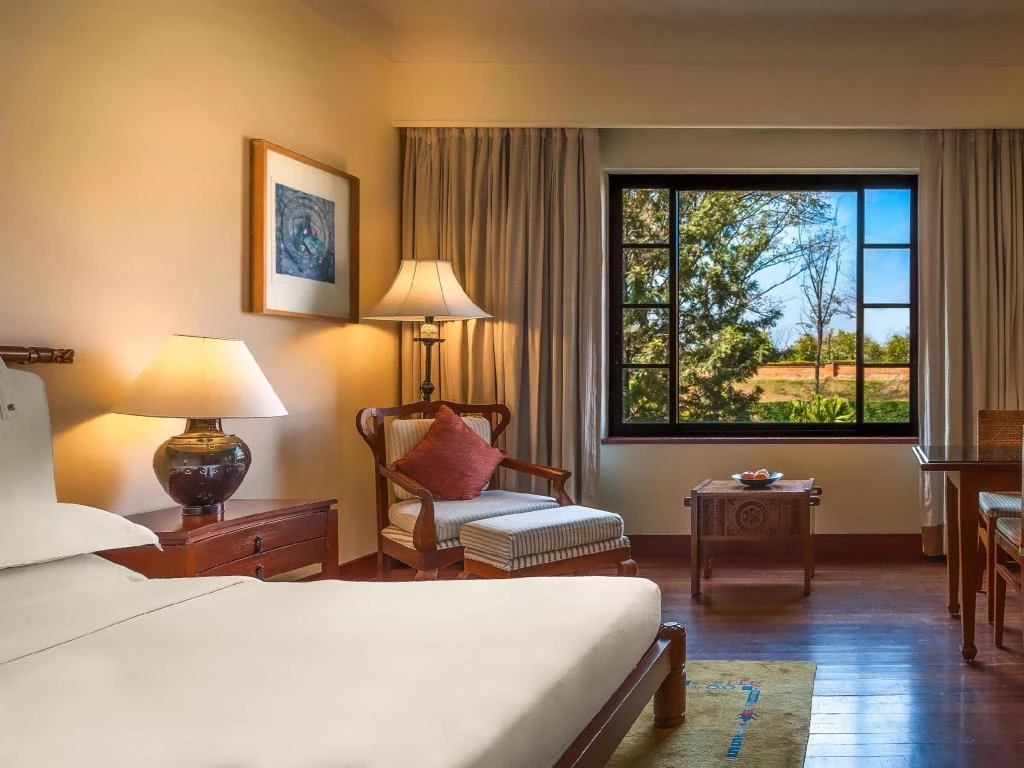
Hyatt Regency Kathmandu
Hyatt Regency Kathmandu is a five-star luxury hotel and resort in Kathmandu, set on 37 acres of landscaped grounds and created in the traditional Newari style of Nepalese architecture. This beautiful hotel and resort is located on the road to the Boudhanath Stupa: the most holy of all Tibetan Buddhist shrines outside of Tibet and a UNESCO World Heritage Site located within a five-minute walk from the hotel. The hotel is just four kilometres (2.4 miles) from the Tribhuvan International Airport and six kilometres (3.7 miles) from the city center of Kathmandu.
Hyatt Regency Kathmandu
Hyatt Regency Kathmandu is a five-star luxury hotel and resort in Kathmandu, set on 37 acres of landscaped grounds and created in the traditional Newari style of Nepalese architecture. This beautiful hotel and resort is located on the road to the Boudhanath Stupa: the most holy of all Tibetan Buddhist shrines outside of Tibet and a UNESCO World Heritage Site located within a five-minute walk from the hotel. The hotel is just four kilometres (2.4 miles) from the Tribhuvan International Airport and six kilometres (3.7 miles) from the city center of Kathmandu.

The Soaltee Crown Plaza Kathmandu
An exceptional blend of royal and traditional elegance, The Soaltee Kathmandu - Soaltee Nepal’s premier 5 Star Deluxe hotel is set in lush green 12 acres of landscaped area with a magnificent view of the Himalayas. It’s located in peaceful Tahachal just 8km from the Tribhuvan International Airport and 4km from the city center its finest shopping destinations, cultural attractions, and entertainment options in Kathmandu. While staying at this 5-star hotel in Kathmandu, you enjoy a range of prime amenities. Gaze up at the mountains while you float in the pool or unwind with one of our rejuvenating therapies at the Tranquility Spa, the largest in the city.
The Soaltee Crown Plaza Kathmandu
An exceptional blend of royal and traditional elegance, The Soaltee Kathmandu - Soaltee Nepal’s premier 5 Star Deluxe hotel is set in lush green 12 acres of landscaped area with a magnificent view of the Himalayas. It’s located in peaceful Tahachal just 8km from the Tribhuvan International Airport and 4km from the city center its finest shopping destinations, cultural attractions, and entertainment options in Kathmandu. While staying at this 5-star hotel in Kathmandu, you enjoy a range of prime amenities. Gaze up at the mountains while you float in the pool or unwind with one of our rejuvenating therapies at the Tranquility Spa, the largest in the city.
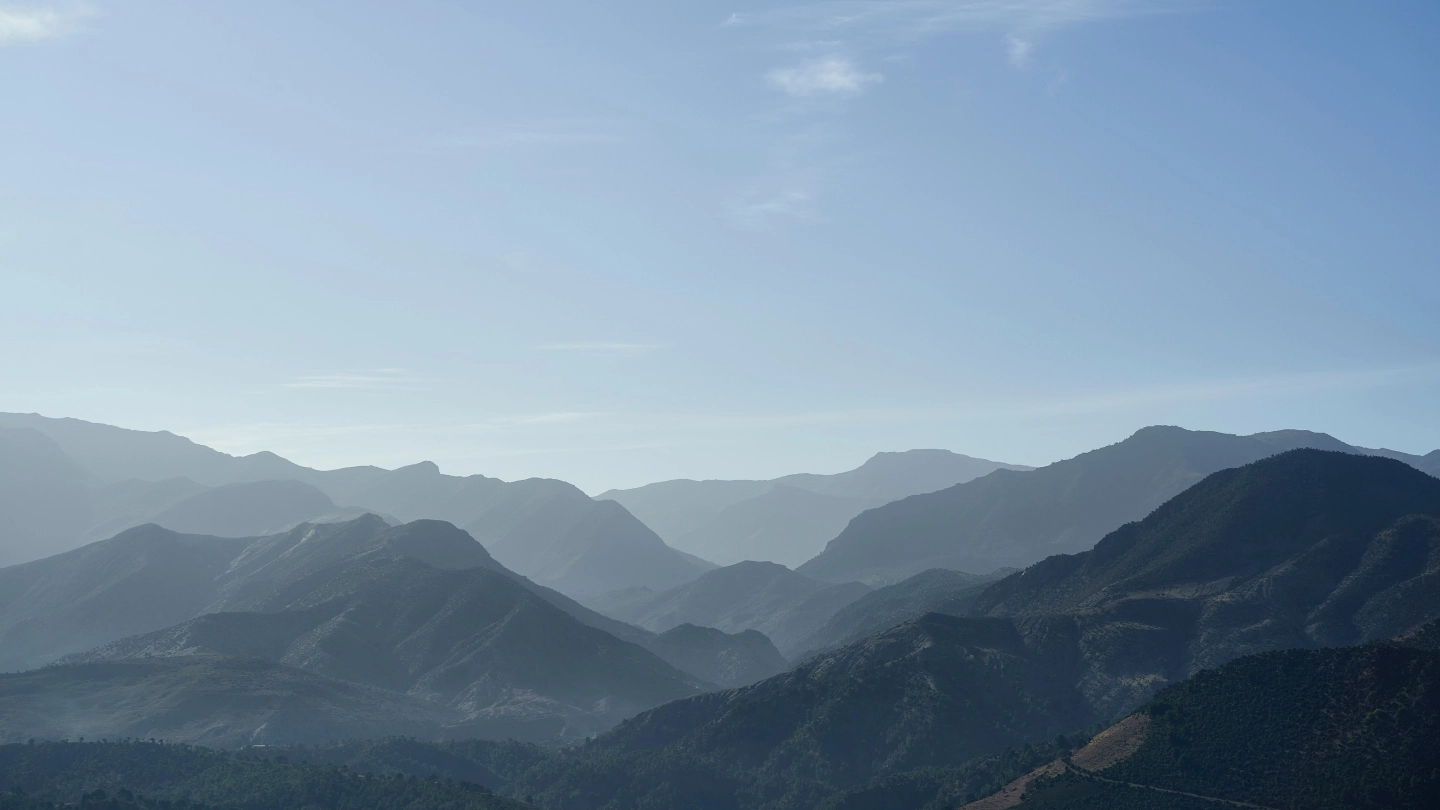
Why Adventure Asia
The company aims to serve soft/medium vacation options to the experienced adventure customer seeking uniquely styled expeditions, rather than traditional tourist-oriented itineraries that are prevalent.
Event Festival
Browse a month-by-month breakdown of suggested itineraries, seasonal activities, climate considerations and festivals.
Phalgun Festivals
Kathmandu explodes into a whirlpool of colour, dance, music and rhythm with the annual Phalgun festivals – Losar, Shivaratri and Holi. Expect everything from public bathing ceremonies to people committing extreme feats of weight lifting with their body parts! With Tibetan rice wine flowing and an amazing array of festive food on offer – this is a great time to be in Kathmandu.
Weather and Climate
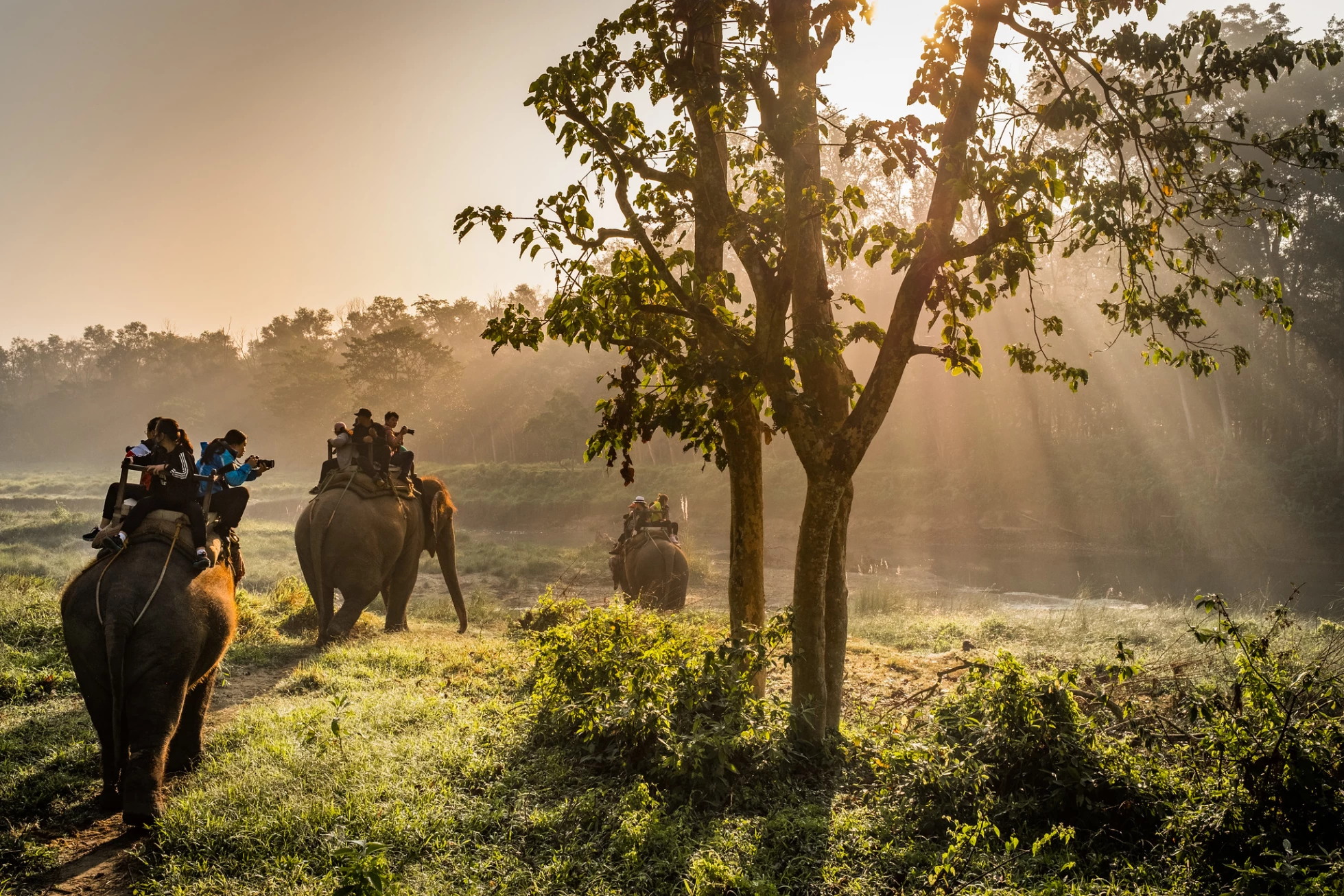
The best time to come to Nepal
Nepal’s climate varies with its topography and altitude, ranging from the tropical to the arctic. The low-land Terai region in the tropical southern part of the country, has a hot and humid climate that can rise above 45 Degree Celsius (113 Degree Fahrenheit) during summer. The mid-land regions are pleasant almost all the year round, although winter nights are cool. The northern mountain region has an alpine climate with considerably lower temperature in winter, especially , at altitudes above 3300m.
The Seasons
Trekking in Nepal can be undertaken throughout the year. with four distinct seasons each with different attractions to offer:
Spring (between March – May)
Springtime temperatures are mildly warm in the lowlands and moderate at higher altitudes, with plenty of opportunities for clear mountain views. It is also the time for flowers to blossom, and the national flower of Nepal – rhododendron – coats the mountainsides with its colorful beauty throughout the spring.
Summer (between June – August)
This is also the monsoon season in Nepal. The weather is hot and wet at times. It rains almost everyday with occasional thunderstorms in the evening, though mornings are often clear and you can expect beautiful sunrises.
This is the favorite season to trek in the arid rain shadow areas like Upper Mustang, Dolpo and Kailash. This season is also recommended for forest researchers and botanists. The advantages of trekking in the summer months are the uncrowded trails and the less cold in the high mountains.
Autumn (between September – November)
This is the best trekking season in Nepal. The weather is very pleasant and clear so the mountain views are the best. This is the peak season for trekking as mountain views are guaranteed so it’s wise to books your flights well in advance. This is also the season of festivals as Nepal celebrates the biggest Hindu festivals – Dashain followed by Tihar.
Winter (between December – February)
The weather is cool and the sky is clear with occasional snowfalls at higher elevations. This season is best for trekking in lower elevations generally below 3200m.. The mornings and nights are cold but daytime temperatures are mild when it is sunny.
Temperature and Rainfall
Nepal is the country of extremes. The low-land plains of the Terai can have tropical temperatures and also mosquitoes, particularly in the summer months. The Himalayas can get to sub-zero temperatures, but the sun can bring some warmth during the day, even in the mountains. The temperature of Kathmandu goes below 1 Degree Celsius (34 Degree Fahrenheit) in winter and rises to an average of 25 Degree Celsius (77 Degree Fahrenheit) in summer.
The average temperature in Kathmandu during the four seasons:
– Spring season: 16-23 Degree Celsius (61-73 Degree Fahrenheit)
– Summer season: 23-25 Degree Celsius (73-77 Degree Fahrenheit)
– Autumn season: 15-24 Degree Celsius (59-75 Degree Fahrenheit)
– Winter season: 9-12 Degree Celsius (48-54 Degree Fahrenheit)
During the rainy monsoon season between June to August, it rains to an average between 200-375 millimeters in Kathmandu. There is occasional rainfall during the other seasons too. In an average, 1300 millimeters of rain falls in Kathmandu every year.
Travel FAQs
Essential Information
Early History Nepal has been inhabited by people for more than 2,500 years, with evidence suggesting tribes of mountain-dwelling people moved to the area from China and other Central Asian regions. Due to a lack of archaeological evidence, little is known about the early periods of history in Nepal, with legend and folklore providing the backdrop to this kingdom of mystery. Ruled early on by the Kirati Dynasty, Nepal continued to be ruled by a succession of dynasties until the Malla Dynasty emerged in the 12th century. During this time, the kingdom expanded rapidly and widely before evolving into small communities with local rule. By the 15th century many temples and palaces had been built in Nepal, some of which are still in existence either as functioning temples or UNESCO World Heritage sites. The kingdom of Nepal was unified by King Shah in 1768, and went on to sign commercial treaties with Britain in 1792 and 1816 after hostilities with the British East India Company. Recent History Nepal held its first elections in 1959, but with the king dissolving parliament and banning political parties soon after, Nepal’s monarchy retained power. After decades of pro-democracy movements, Nepal was finally declared a democratic republic in 2008, with Nepal’s monarchy being removed from power after ruling for more than 240 years. Nepal celebrated its Year of Tourism in 2011, with arrivals increasing year upon year since 2006 due to increased infrastructure, expansion of air travel and the enduring popularity of the Himalayas and mighty Mount Everest.
Getting There
Kathmandu is the international airport in Nepal. Typically, the flights arrive in the early afternoon, you have some time to walk around and enjoy dinner that evening. The departure tax out of Kathmandu is about $26. From the U.S., you will most likely fly through Bangkok (Thai Air), New Delhi, or another city in Asia, and you may have to overnight in this city. Because of the dateline and the overnight, it takes 3 days to get to Kathmandu. AWR can help book a hotel and transfers in Bangkok and New Delhi for you. From Europe, flights depart from many major cities. There will be at least one stop en route to Kathmandu, depending on the airlines. It is at least 15 hours of travel time one-way. Overnight in New Delhi: If you need to spend the night in New Delhi on your way to Nepal, you can stay at the Eaton Smart New Delhi Airport Transit Hotel without needing an India visa. Rooms are about $120. If you stay more than 8 hours in the room, add another $20 for taxes. To leave the secured area of the airport, you will need to arrange an India visa ahead of time. AWR can help arrange your local and international flights.
Getting Around
Getting around is one of the biggest challenges of travelling in Nepal. Distances aren’t great, but the roads are poor and extremely slow, and public buses are crowded and uncomfortable. Tourist buses are available on the main routes, however, and you can always hire a motorcycle, or charter a taxi, car or 4WD vehicle, or catch a flight. Nepal’s highways are irregularly maintained, and each monsoon takes a toll on surfaces. Wherever you travel, the route will probably be new in parts, disintegrated in places, and under construction in others. The country has a truly appalling road safety record, and accidents are common. And, in addition, blockades or general strikes (bandh) can at times make travel virtually impossible. By bus Allowing for bad roads, overloaded buses, tea stops, meal stops, the constant picking up and letting off of passengers, and the occasional flat tyre or worse, the average bus speed in the hills is barely 25–30km per hour, and on remote, unpaved roads it can be half that. Along the Terai’s Mahendra Highway, it’s more like 50km per hour in an express bus. Bus frequencies and approximate journey times are given throughout this guide. Inevitably, these figures should be taken with a pinch of salt: the bus network seems to grow every year, but political troubles or festivals can dramatically reduce the number of buses, and some gravel or dirt roads are closed altogether during the monsoon. Open-air bus stations (also known as bas parks or bas islands) are typically located in the dustiest parts of town. Tickets are generally sold from a small booth. Destinations may not be written in English, but people are almost always happy to help you out if you ask. In Kathmandu and Pokhara you may find it easier to make arrangements through a travel agent (though make sure it’s one you’ve been recommended), while in cities you can ask your hotel to buy a ticket for you. Even the longest journeys on public buses should cost no more than Rs500. Regular tourist buses connect Kathmandu with Pokhara, Sauraha (for Chitwan National Park) and Sonauli, as well as Pokhara with Sauraha and Sonauli. The vehicles are usually in good condition, making for a safer ride than in a regular bus. They aren’t supposed to take more passengers than there are seats, so the journey should also be more comfortable and quicker too. Some companies use minibuses, which are somewhat quicker – occasionally dangerously so. Book seats at least one or two days in advance. Note that ticket agents often add an undisclosed commission onto the price. Long-distance public bus services generally operate on an express basis – meaning they stop at scheduled points only. They’re faster and more comfortable than local buses. Express buses fall into two categories: day buses, which usually set off in the morning, and night buses, which usually depart in the afternoon or early evening. Night buses are generally more comfortable, though legroom is always in short supply, and between all the lurching, honking, tea stops and blaring music you won’t get much sleep (bring earplugs and an eye mask). Night journeys are also significantly more dangerous, and it’s not uncommon for drivers to fall asleep at the wheel. Like tourist buses, and unlike local buses, express buses allow you to reserve seats in advance. Do this, or you could end up in one of the ejector seats along the back. Numbering begins from the front of the bus: the prized seats #1A and #2A, on the left by the front door, often have the most legroom. You can usually get away with buying a ticket just a few hours beforehand, except during the big festivals, when you should book as far in advance as possible.
Visa and Permits
All foreign nationals (except Indian passport holders) require a visa to enter Nepal. Visas are obtainable from embassies abroad, land borders (including borders with India & Tibet) and on arrival at Kathmandu’s Tribhuvan Airport. Getting a visa at the airport or land borders can sometimes take time due to long queues. There have been instances when travellers are asked to show proof of exit from the country, ie flight tickets. You may also need to provide two passport photos and the following fees in US dollars (subject to change, cash only). Other currencies are also accepted although rates may differ.
Local Customs
With more than 30 different ethnic groups and a wide range of religions and language dialects, Nepalese society is rich in diversity. With Indian, Tibetan, Chinese and Mongolian influences, Nepalese food, clothing, customs and music vary, depending on what area you’re travelling in and what ethnicity people belong to or identify with. Hinduism is the dominant religion, followed by Buddhism. Standing alongside these religions, there are also small populations of people who follow Islam and Christianity. Simultaneously, animist beliefs and belief in spirits is common throughout Nepal, particularly within rural communities. Like India, the caste system exists in Nepal, as does the custom of arranged marriage. As one of the least urbanised countries in the world, life differs greatly between the rural and city-dwelling populations, with rural people largely living a very simple, traditional life – slow-paced, village-based, in connection to their family and local community. Visitors will be charmed by the hospitality of Nepalese people, who are generally very friendly and welcoming of travellers.
Events and Festivals
Phalgun Festivals Kathmandu explodes into a whirlpool of colour, dance, music and rhythm with the annual Phalgun festivals – Losar, Shivaratri and Holi. Expect everything from public bathing ceremonies to people committing extreme feats of weight lifting with their body parts! With Tibetan rice wine flowing and an amazing array of festive food on offer – this is a great time to be in Kathmandu. Indra Jatra This eight-day festival held in Kathmandu features ceremonies, dancing and displays of spirituality, but none of these events compare to the spectacle of the third day when Kumari (the living goddess) tours the city streets aboard a chariot. Other popular gods also come out to play and parade, as masked dancers perform in Durbar Square in this exceptional display of local culture. Mani Rimdu Festival Offering a rare chance to observe the Sherpa culture of the Everest region, this festival held at Tengboche Monastery features days of meditation cycles, religious ceremonies, masked dances and parades. This holy time for Buddhists sees locals travel by foot to receive blessings en masse against a stunning Himalayan backdrop.
How difficult are the treks?
This depends on where you want to trek, the altitude and the duration of the trek. The shorter treks tend to be easier while the longer ones require more physical fitness. Be aware that the high altitude, thin air and your current fitness also will play a major part in your interpretation of the word “difficult”. You will usually trek 4 – 6 hours per day. Most treks are of difficult enough to require good physical fitness or some and/or endurance training prior to the trek.
What type of shoes or boots should I wear?
That depends on the type of trek. Shorter treks at low altitudes can be done in running shoes while longer, more demanding treks at high altitudes require sturdy trekking or hiking boots. It is best to buy shoes and boots before arriving in Nepal, and to break them in before arriving for your trek.
When is the trekking season?
The best time to trek is from October to May. The first two months of the dry season – October and November, when it is still comfortably warm – are ideal for trekking in Nepal. December, January and February are still good months for trekking, but it can be bitterly cold at high altitudes. The spring, March – May are also good trekking months when the mountain flowers are in bloom and the weather is relatively mild. The summer months bring monsoon rainy weather when trekking is not ideal except for selected areas in Nepal.
What about the risk of altitude sickness?
Adventure Asia will always give our guest the necessary time to acclimatize to higher altitudes. Our guides and helpers are trained to spot any signs of altitude sickness (AMS) and know how to handle the problem. They can also provide you with Diamox and other aids to alleviate AMS symptoms
What happens if there is an emergency?
Our guides are trained in first aid and can deal with most of the basic ailments that can occur during a trek. If an emergency occurs, professional help from a rescue organization will be needed. That is why every client should have their own emergency rescue and health insurance arranged before coming to Nepal.
How much money should I bring for the trek?
The amount of money you bring on a trek depends on you. Cold sodas during the day and an occasional beer after a long day of trekking is a welcome treat. You may also want to buy additional food or souvenirs. We recommend having about US $10/day for these possible expenses.
What's your refund policy ?
Below is our cancellation and refund policy: 🔸 60 days prior to arrival date: No cancellation charge for the land cost. We guarantee 100% of the land cost back. The airline cancellation fees are applied according to the airline's policy. 🔸 59 - 30 days prior to arrival date: 5% cancellation charge + airfare cancellation fees 🔸 29 - 15 days prior to arrival date: 10% + airfare cancellation fees. 🔸 14 - 8 days prior to arrival date: 40 + airfare cancellation fees. 🔸 7 days prior to arrival date: 100% 🔸 No show: 100% Please note that the domestic flight tickets in the package are non-refundable




